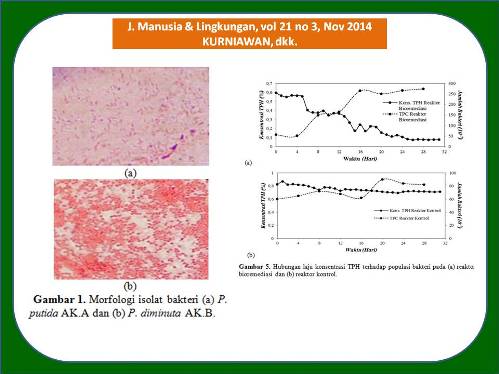
BIODEGRADASI RESIDU TOTAL PETROLEUM HIDROKARBON DI BAWAH KONSENTRASI 1% (W/W) HASIL PROSES BIOREMEDIASI (Biodegradation of Total Petroleum Hydrocarbons Residues below 1% Concentration (W/W) Using Bioremediation Process)
Allen Kurniawan(1*), Agus Jatnika Effendi(2)
(1) Jurusan Teknik Sipil dan Lingkungan, Institut Pertanian Bogor, Kampus IPB Dramaga, Bogor, 16680
(2) Jurusan Teknik Lingkungan, Institut Teknologi Bandung, Jln. Ganesha No. 10, Bandung, 40132
(*) Corresponding Author
Abstract
ABSTRAK
Sektor pertambangan minyak bumi dan gas cenderung menghasilkan limbah yang dipersepsikan sebagai salah satu sumber pencemaran lingkungan. Menurut Keputusan Menteri Lingkungan Hidup Nomor 128/2003, proses bioremediasi merupakan teknologi alternatif untuk meminimalisasi dan memulihkan lahan tercemar dengan melibatkan aktivitas mikroorganisme hingga persyaratan konsentrasi akhir limbah minyak bumi berupa Total Petroleum Hydrocarbons (TPH) kurang dari 1%. Pemilihan mikroorganisme indigenous pada konsentrasi substrat kecil diharapkan menghasilkan nilai saturasi substrat terkecil sehingga tingkat afinitas tertinggi dapat diperoleh. Tujuan penelitian ini mencari dan mengidentifikasi isolat mikroorganisme petrofilik dari contoh uji hasil proses bioremediasi pada konsentrasi TPH 1%, menentukan nilai parameter kinetika biodegradasi, dan mengaplikasikan mikroorganisme terpilih pada proses bioremediasi tipe landfarming. Tahap isolasi dan identifikasi bakteri indigenous menghasilkan isolat bakteri Pseudomonas putida AK.A dan Pseudomonas diminuta AK.B. Penentuan kinetika biodegradasi dilakukan pada setiap jenis isolat dan kultur tercampur. Nilai laju pertumbuhan spesifik (µ), laju pertumbuhan spesifik maksimum (µmax), konsentrasi setengah jenuh (KS), koefisien produksi sintesis sel (Y), laju utilisasi substrat spesifik (q), laju utilisasi substrat spesifik maksimum (qmax), dan koefisien kematian indigenous (kd) pada P. putida AK.A. berturut-turut sebesar 0,0679-0,0788/jam; 0,078/jam; 0,0152%; 0,1011; 0,6716-0,7794/jam; 0,76/jam; 0,0085/jam; P. diminuta AK.B sebesar 0,0754-0,0874/jam; 0,0873/jam; 0,0182%; 0,1246; 0,7458-0,8645/jam; 0,701/jam; 0,0058/jam; dan kultur tercampur sebesar 0,0825-0,0948/jam 0,0945/jam; 0,016%; 0,2257; 0,8160-0,9377/jam; 0,419/jam; 0,0035/jam. Kultur tercampur digunakan pada reaktor landfarming skala laboratorium. Berdasarkan hasil penelitian, isolat bakteri Pseudomonas dalam kultur tercampur dapat menurunkan konsentrasi TPH di bawah 1%, dengan efisiensi sebesar 87,4% dalam jangka waktu satu bulan.
ABSTRACT
The mining sector of oil and gas are likely to generate waste wbich is perceived as a source of environmental pollution. According to “Keputusan Menteri Lingkungan Hidup No. 128/2003” (Environmental Ministry Decree), the process of bioremediation is an alternative technology to minimize and recover land which polluted by microorganism activities until the final requirements of petroleum waste concentration is less than 1%. Indigenous microorganisms elected on small substrate concentrations are expected to get the smallest saturation value of the substrate so the highest affinity level can be obtained. The purpose of the research sought and identified petrofilic microorganisms isolated by bioremediation process resulted of 1% Total Petroleum Hydrocarbons concentration, determined the value of biodegradation kinetic parameters, and applied the microorganisms selected on bioremediation process of landfarming. The isolation and identification of indigenous bacteria process produced Pseudomonas putida AK.A and Pseudomonas diminuta AK.B. Determination of biodegradation kinetics was performed on each isolate and mixed culture. The value of specific growth rate (μ), maximum specific growth rate (μmax), the concentration of half saturation (KS), the synthesis of cell production coefficient (Y), specific substrate utilization rate (q), maximum specific substrate utilization rate (qmax), and endogenous decay coefficient (kd) for P. putida AK.A are 0.0679-0.0788/hour; 0.078/hour; 0.0152%; 0.1011; 0.6716-0.7794/hour; 0.76/hour; 0.0085/hour; P. diminuta AK.B are 0.0754-0.0874/hour; 0.0873/hour; 0.0182%; 0.1246; 0.7458-0.8645/hour; 0.701/hour; 0.0058/hour; meanwhile for mix culture are 0.0825-0.0948/hour; 0.0945/hour; 0.016%; 0.2257; 0.8160-0.9377/hour; 0.419/hour; 0.0035/hour. The mixed culture bacteria was used on landfarming reactor. Based on the results, isolates of Pseudomonas bacteria in mixed cultures can reduce TPH concentrations below 1% at landfarming reactor.
Keywords
Full Text:
Artikel lengkap (PDF) (Bahasa Indonesia)References
Abbasi, B.E., dan Shquirat, W.D., 2007. Kinetics of Indigenous Isolated Bacteria Used for Ex-situ Bioremediation of Petroleum Contaminated Soil. American-Eurasian J. Agricul. & Environ. Sci. 2(6):761-766.
Ahmad, A., 2003. Penentuan Parameter Kinetika Proses Biodegradasi Anaerob Limbah Cair Pabrik Kelapa Sawit. Jurnal Natur Indonesia; 6(1):45-48.
Asia, I.O., Enweani, I.B., dan Eguavoen I.O., 2006. Characterization and Treatment of Sludge from the Petroleum Industry. African J. Biotechn. 5(5):461-466.
Cowan, S.T. 1975. Manual for the Identification of Medical Bacteria. Cambridge University Press, Cambridge.
Doran, P.M., 1995. Bioprocess Engineering Principles. Academic Press, Oxford.
Effendi, A.J., 2006. Treatibilty Test of Oil-Contaminated Soil Using Bio-Augmented Bacteria. Jurnal Infrastruktur dan Lingkungan Binaan, 2(2):41-47.
Ekpo, M.A., dan Udofia, U.S., 2008. Rate of Biodegradation of Crude Oil by Microorganisms Isolated from Oil Sludge Environment. African Journal of Biotechnology; 7(24):4495-4499.
Grady Jr., C.P.L., Daigger, G.T., dan Lim, H.C., 1999. Biological Wastewater Treatment. Marcel Dekker, New York.
Helmy, Q., 2006. Pengaruh Penambahan Surfaktan Terhadap Biodegradasi Sludge Minyak Bumi Oleh Konsorsium Bakteri Petrofilik. Tesis, Fakultas Teknik Sipil dan Lingkungan ITB, Bandung.
Ibrahim, B., Erungan A.C., dan Heriyanto, 2009. Nilai Parameter Biokinetika Proses Denitrifikasi Limbah Cair Industri Perikanan pada Rasio COD/TKN yang Berbeda. Jurnal Pengolahan Hasil Perikanan Indonesia; 12(1):31-45.
Notodarmojo, S., 2005. Pencemaran Tanah dan Air Tanah, Penerbit ITB, Bandung.
Okpokwasili, G.C., dan Nweke C.O. 2005. Microbial Growth and Substrate Utilization Kinetics. African Journal of Biotechnology; 5(4):305-317.
Pazouki, M., Najafpour, G., dan Hosseini, M.R., 2008. Kinetic Models of Cell Growth, Substrate Utilization and Bio-decolorization of Distillery Wastewater by Aspergillus fumigatus UB260. African Journal of Biotechnology; 7(9):1369-1376.
Reardon, K.F., Mosteller, D.C., Rogers, J.B., DuTeau, N.M., dan Kim, K., 2002. Biodegradation Kinetics of Aromatic Hydrocarbon Mixtures by Pure and Mixed Bacterial Cultures. Environmental Health Perspectives; 110(6):1005-1011.
Rittmann, B.E., dan McCarthy, P.L., 2001. Environmental Biotechnology, McGraw-Hill, Singapura.
Schuler, M.L., dan Kargi, F. 2002. Bioprocess Engineering Basic Concepts. Prentice Hall, New Jersey.
Tchobanoglous, G., Burton, F.L., dan Stensel, H.D., 2003. Wastewater Engineering: Treatment and Reuse. Edisi 4, McGraw-Hill, New York.
Tribuwono, B.R., 2006. Kinetika Biodegradasi Limbah Minyak Bumi Menggunakan Reaktor Batch Bioslurry. Skripsi, Fakultas Arsitektur Lansekap dan Teknologi Lingkungan Universitas Trisakti, Jakarta.
Article Metrics
Refbacks
- There are currently no refbacks.
Copyright (c) 2017 Jurnal Manusia dan Lingkungan







